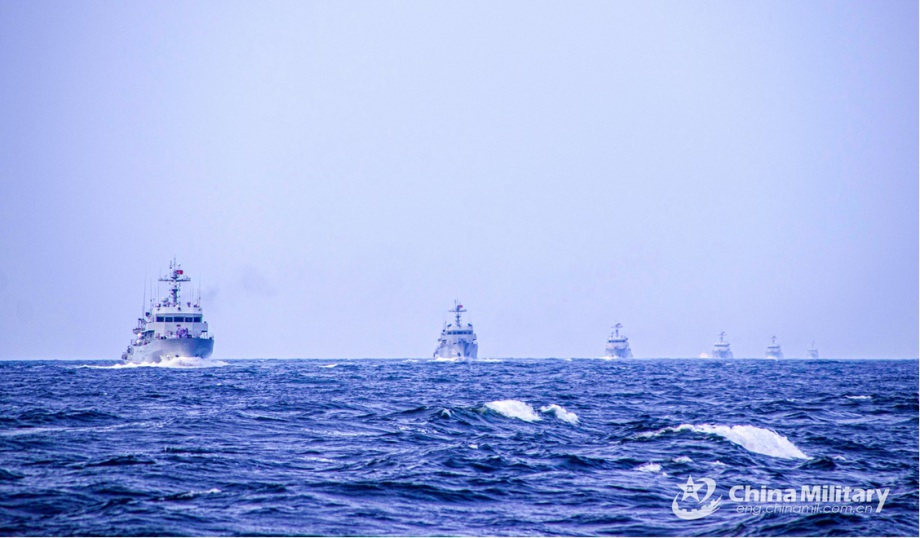Mines in the oceans and what to do about it
Vessels attached to a naval minesweeper flotilla of the PLA Navy sail in formation during a round-the-clock mine-countermeasures (MCM) training exercise. The exercise, which was held in unfamiliar sea areas from September 9 to September 13, 2023, aimed to hone the troops' combat capabilities. (eng.chinamil.com.cn/Photo by He Yuqian)
Mine-laying activities in the seas between China and Taiwan – a threat to world peace?
Mines, both on land and in the water, are in widespread use all over the world. Their deployment is particularly significant in situations of active conflict, or in cases where such a conflict has a significant probability of developing.
An example is the Ukraine, where it is estimated that some 30-40% of its territory is affected by land mines, mostly deployed by Russian forces.[1] Besides the strategic objectives of such deployment, the consequences for civilian populations and the environment are severe.
An area where intense activity surrounding mine laying and removal is envisaged are the East and South China Seas and the straight near Taiwan. As a consequence of such activities during World War II civilians were affected in Japan many years later.[2] The significance of mines in this geo-strategic location is evidenced by the fact that mines appear to be a relatively economic way of achieving objectives involving high value targets.
The stakes involved are large, and China places a high emphasis on mining and mine-counter-measure capabilities. In the terms employed by China’s People’s Liberation Army “naval mines are easy to lay and hard to sweep”[3], and their role in the navy is well established from historical origins right to the resent day.[4]
Interestingly, the power most active in mine deployment in the Far East also appears to be making the most efforts in mine removal. A table[5] summarizing the ship-bound mine removal capabilities (such as mine countermeasure vessels and uncrewed surface vessels) of China, Japan and the United States in 2023 shows that China far surpasses the other countries:
|
Type/Country |
China |
Japan |
United States |
|
MCM vessels |
40 + |
21 |
8 (−8 in 2024) |
|
Can control USVs |
Included in above |
4 + 18 (see note 7) |
9 + 4 (see note 7) |
|
USVs |
15 + |
+ (see note 7) |
4 |
|
Total |
55 + |
25 + 18 |
17 − 4 13 (from 2024) |
|
Ship type |
Type 081A Type 082 I and II Type 529 |
Sugashima class Hatsushima class Awaji class FFM Mogami class |
Avenger class Freedom class USV (excl. Independence class) |
Moreover, the US is planning to decommission its existing mining countermeasures fleet in 2023, consisting of 1300 t Avenger class vessels, and the planned replacement Freedom-class ships are plagued by operational issues due to the sophisticated transmission systems required in a propulsion system powered both by conventional diesel engines and faster turbines. This latter programme has taken the better part of 20 years to launch and implement, and it is still uncertain when the vessels to replace the older minesweeper fleet will be commissioned. Above all, the envisaged numbers appear to be no match in quantitative terms for the huge fleet of mine countermeasure vessels both specific and ad hoc that China can muster.[6]
Given the potentially very significant role that mining and demining activities could play in a possible Taiwan-centered conflict in the region, there appears to be an urgent need by the free world’s navies to better address the issue, in order to counter possible future threats and encompass mining and demining in their overall strategies.
Besides the conflict related role of mining, the environmental issues of ocean pollution by mines and related activities loom large. This in itself would seem a strong argument to pay increased attention to the subject.
Succes in mine laying and mine countermeasures, in conjunction with meeting the other main challenges of antisubmarine warfare, and successful ship missile defence, have been identified by the PLAN as decisive in deciding who controls the seas, and whether the peace will be maintained and the chances of a preserved environment kept intact.
[2] Several instances of the consequences of drifting mines are mentioned in the article on “Mine Warfare in a Taiwan Contingency – Scenarios for Naval Mine Use and Its Impact on Japan” by Y. Kawakami - see https://www.spf.org/iina/en/articles/kawakami_01.html
[3] Quoted in “China Maritime Report No. 29: PLAN Mine Countermeasures: Platforms, Training, and Civil-Military Integration” by B. Waidelich and G. Pollitt – see https://digital-commons.usnwc.edu/cmsi-maritime-reports/29/
[4] For a survey of the background up to about 2009 see “Chinese Mine Warfare - A PLA Navy ‘Assassin’s Mace’ Capability” by A. S. Erickson, L.J. Goldstein, and W.S. Murray referred under http://digital-commons.usnwc.edu/cmsi-red-books/7
[5] “Have China’s Mine Countermeasures Capabilities Eclipsed Those of Japan and the United States?”, article by Y. Kawakami – see https://www.spf.org/iina/en/articles/kawakami_03.html
[6] An appeal to take counter-mine measures more seriously is “Get Serious About Countering China’s Mine Warfare Advantage” by A.J. Douglas referenced under https://www.usni.org/magazines/proceedings/2023/june/get-serious-about-countering-chinas-mine-warfare-advantage


